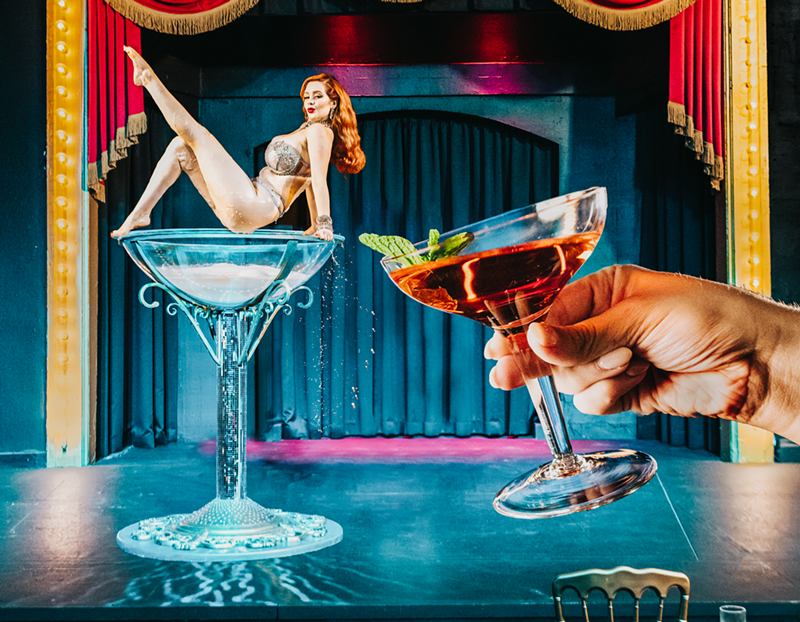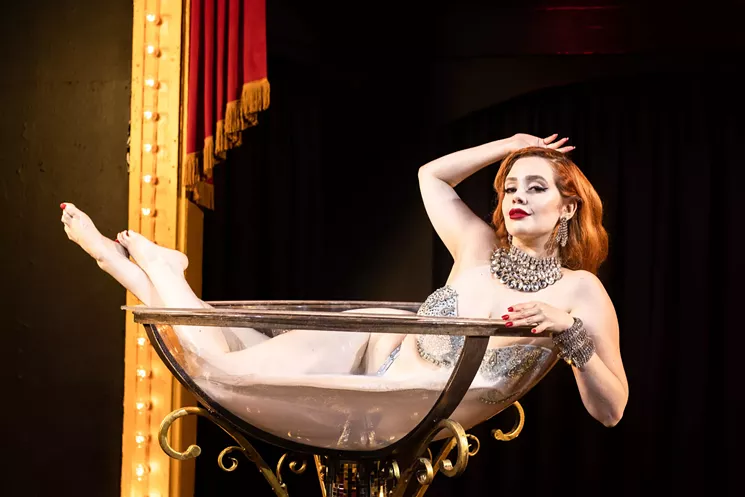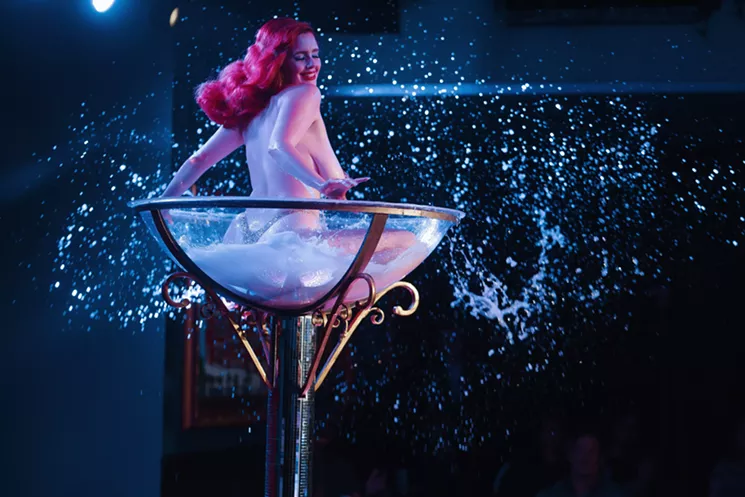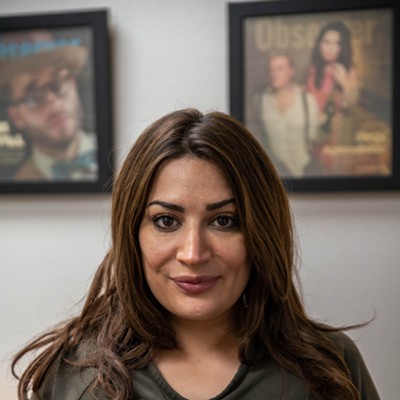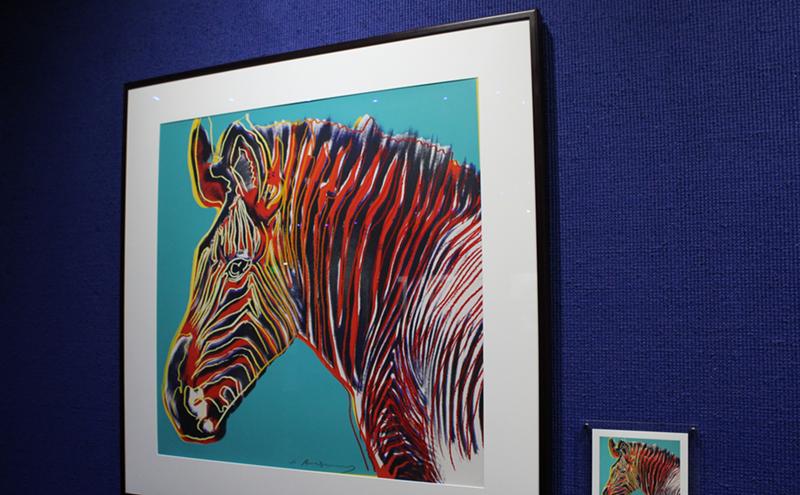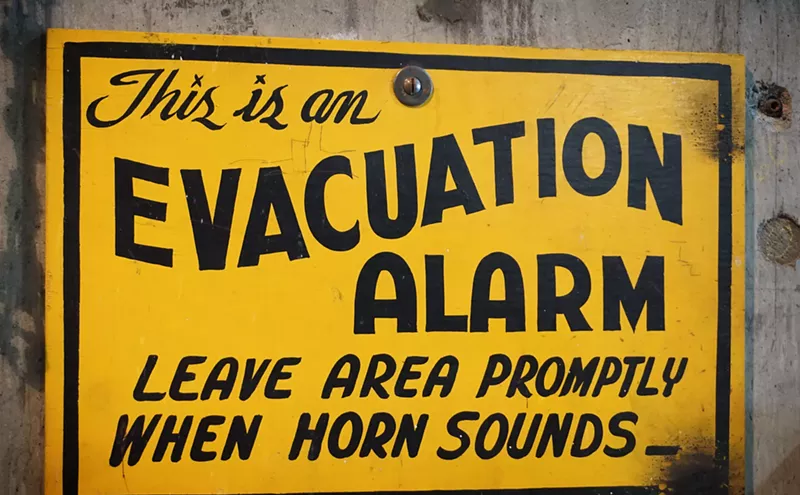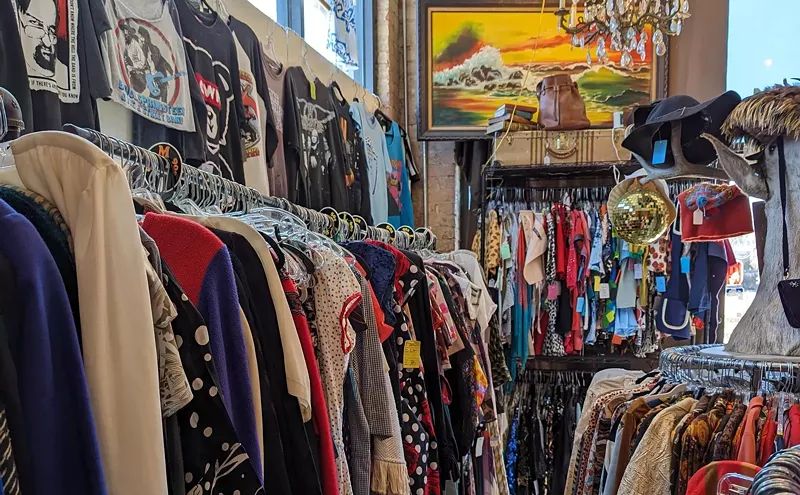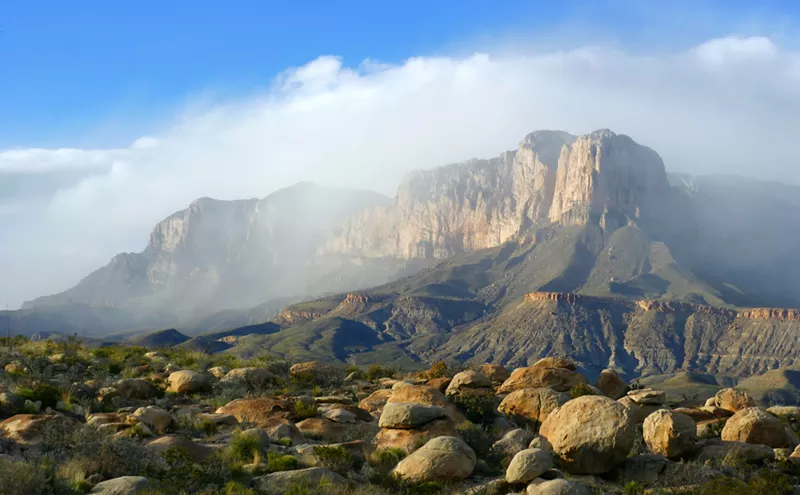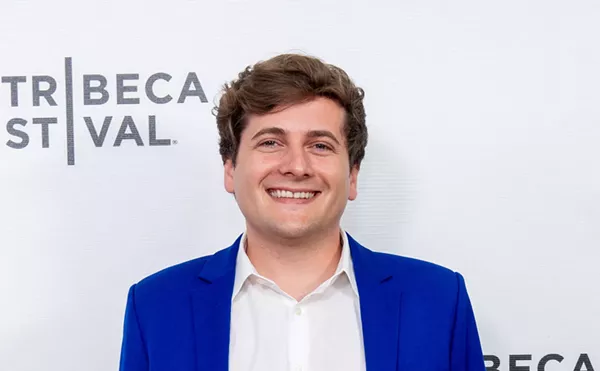On the last Saturday of July, an entranced crowd circled the stage at the Cambridge Room at Dallas’ House of Blues. One by one, burlesque dancers took their places under the spotlight, teasing the audience in an open-room peepshow, appealing to the strokes of all folks with the dancers’ varied sizes, ages and looks.
They all shared one thing, however: The vixens onstage had an eerily authentic air recalling burlesque’s heyday. The venue’s new monthly series is called Carousel Club Burlesque and is inspired by the old Dallas troupe from the Carousel Club, once owned by Jack Ruby, the man who killed Lee Harvey Oswald.
Headliner Minxie Mimieux is the mastermind behind this timeless fantasy. She closes the show by climbing into a giant Champagne coupe, though the prop is hardly noticeable when it’s next to her bouncing presence.
The raven-locked beauty splashes around the glass, becoming the orange in a luscious mimosa; she shimmers, winks and flirts while soaking herself in bubbles and spinning around the rim of the glass.
Minxie’s red-hot act whips the crowd into butter with every feather-soft move, but no one is enjoying the show more than a woman to the left of the stage, whose enthusiastically loud offstage remarks border on catcalling.
Minxie surely doesn’t mind this sort of response. Most of her loyal following, she says, is made up of women, which isn’t as surprising at it might seem. Her magnetism gains power through burlesque’s artistry and her accomplished styling, costuming and choreography. There’s something particularly satisfying about watching a woman command an audience by using her sexuality to her favor.
Since the days of Ruby’s club, Dallas has maintained a strong taste for burlesque, giving performers like Minxie an ever-shining spotlight.
Through a decade of tassel-twirling performances, there are some things, however, the dancer reserved from audiences. Minxie promised herself long ago that she would never do full nudity unless she got a call from Playboy, and she kept her word.
The call came this year — or rather, an Instagram message — from Playboy photographer Madeline Northway, who was looking for a Texas cowgirl type for an upcoming shoot in Los Angeles when she found a muse in the burlesque star from Dallas.“I would say it takes dedication, passion and — ultimately, like with any type of performer — a willingness for scrutiny. You have to kind of be ready to not be approved of." – Minxie Mimieux
tweet this
“Scanning through videos of her performances, I was captivated by the way she moves so elegantly, commanding attention but doing so with such softness and ease,” Northway says. “She has such a timeless look and spirit. I recall seeing a black-and-white shot from one of her performances, and I could have sworn it was a photograph straight from the 1940s.”
The shoot for a two-part editorial took place at the Dresden Room, a Hollywood landmark where, Northway says, Minxie “filled the characters as a cabaret performer wearing an authentic vintage showgirl costume and then also adapting the style of 1970s Hollywood glamour.
“It was such an honor for me to welcome Minxie to the Playboy family,” Northway says, “her being such an incredible talent but also a truly beautiful and magnetizing spirit.”
The first Playboy spread came out this May, and the other in July. The shoot for both articles took place in March over two nine-hour days with a COVID-restricted, all-female crew. It was a dream Minxie thought she must’ve “manifested” when she made herself that promise. For the shoot, she also got a “healthy budget” to play dress-up, a way of life for a Texan bombshell.
“I have a lot of fun transforming myself into, you know, like this high-glamour version of myself,” she says. “That’s ‘Minxie,’ and it’s kind of funny. They always say that Texas performers put so much emphasis on hair and costume and just the pageantry of it. Whereas like New York, they’re more thought-provoking and on the edge … but yet the Texas performers want the biggest hair in the biggest costumes and the biggest props.”
Minxie embodies the Texas spirit. Her kittenish retro glamour borders on cartoonish. Her props, showmanship and laugh are gigantic.
She didn’t always look like Jessica Rabbit. Minxie (who keeps her original name private) grew up as “100 percent a tomboy.” In high school, she was less old Hollywood siren and more London punk, rocking a black-and-white Mohawk hairstyle.
“I wasn’t really in touch with my femininity,” she says. “And burlesque definitely brought me into accepting, like, my feminine energy.”
Minxie grew up in Arlington, an only child to divorced parents, learning to paint with her father and watching her mother break into the world of film. Minxie rebelled and had no interest in the career of child modeling and acting she’d grown into.
“Whenever I was little, I wanted to be, generally, an artist,” she says. “I’ve always been involved in the arts, be it from theater to painting, drawing. I’ve dabbled in photography, which ultimately kind of brought me full circle to modeling. ... I knew I wanted to be with the arts but I wasn’t really sure. My mom raised me in the arts — my mom’s an actor, film producer, director — and so I knew that it was possible to make a life within the arts, but I wasn’t really sure.”
Before she perfected the art of the tease, Minxie tried traditional creative mediums. She’d been in advanced placement art classes throughout high school, briefly attended art school, got accepted into a culinary school in New York but decided to stay close to home at the culinary program at El Centro in Dallas.
“All my jobs had been back of the house kitchen,” she says. “My first job ever was baking Key lime pies at a barbecue restaurant. So I had a passion for cooking that I really thought I wanted to maximize on.”
She only attended for one semester. Traditional schooling just wasn’t for her, no matter the subject. Instead, she set out to boil the blood of audiences as a sexpot burlesque dancer.
“Not to sound so, like, Beastie Boys about it, like, ‘fight for my right to party,’ but I wanted to just do other things,” Minxie says. “I just wanted to learn more about the real world and not be in a classroom.”
The seed to her blossoming career was planted one day as she was browsing through old kung fu movies at a vintage film company called Something Weird, where she found a “random VHS” of an old burlesque film.
“I’m queer,” she says, “and at first, I started just really being attracted to these vintage vixens, and I was like, ‘Whoa, they’re hot.’ And I just never really saw myself, you know, as hot and empowered. I just never really saw myself capable of being in that feminine role, and burlesque definitely helped me tap into that.”
Minxie began to teach herself burlesque and pursue her pinup dreams. With a new name, a new life followed. She put together a short-lived DIY troupe with friends, The Deadly Dolls, and was taken under the boa-feathered wings of performer Ginger Valentine, who now works with burlesque megastar Dita Von Teese and who trained Minxie and became her mentor.
Minxie became a guest performer on different burlesque shows, mostly at the Kessler Theater, where she caught the attention of different producers. And the requests kept coming. Today she performs frequently in New York, though she says her largest fan base is in Los Angeles, where she’s booked up for the next few months.
But Minxie doesn’t sit on a chaise lounge at home waiting for her phone to ring with offers. She hustles her way into a full performing schedule by acting as her own booking agent, stacking as many as three gigs in one night.
“I booked myself, basically, reaching out to producers and being like, ‘Hey, I want to go to New York to perform. Do you have a spot for me?” she says. “I pretty much just started doing that in different cities and meeting people and networking with people and producers and learning how to produce ultimately by watching others around me.”
Minxie says she “developed as a performer,” however, strutting the stages of the Big Easy. In New Orleans, she headlined a festival for the first time. It was 2016, and a new iteration of an old festival where her idols, including Valentine, had won the coveted title of “Queen of Burlesque” in the past. There were about 10 international competitors, whom Minxie calls “the crème de la crème,” of the industry.
“I competed for Queen of Burlesque and I won!” Minxie says, as excitedly as if it had just happened. “I competed against performers from all around the world who, you know, I felt stacked against … not that I didn’t have, you know, some cool vibes going too, but just immaculate costumes, immaculate bodies, performers I had looked up to already, you know? And they were my competitors — and then I won.”
In the last year and a half, her crown collected dust along with her love of performing. As was the case for most performers, Minxie’s pandemic times were “abysmal,” she says.
“There wasn’t shit going on,” Minxie says, letting out a laugh so bubbly you nearly expect it to end with a pop.
As she built a career in performance, Minxie was a bartender for seven years in Lower Greenville and Deep Ellum. She chose not to go back to serving during the pandemic. She started an Onlyfans, which offers exclusive content to subscribers.
“It was definitely supplemental and it helped me,” she says of the platform, “but I mean there are some performers — more so strictly model types — that are making like 20k a month or more. That certainly was not my experience with it.”
Minxie tried to adjust her act to the digital age, but it wasn’t her medium. A performance act that emerged from live, smoky joints didn’t translate to the screen for Minxie.
“I did a couple of virtual shows but I wasn’t really crazy about it ’cause I just didn’t really like not being able to connect with an audience,” she says.
The pandemic nearly killed her siren dreams before making them bigger.
“It totally changed how I feel about performing; it made me realize how much the connection really is important to me,” she says. “And then there came a turning point where I was like no, I do want to do this and this is like a passion, and I guess it really lit a fire in me that I hadn’t had in like a while.”
During her time at home, Minxie was discovered by Playboy, and she also began planning her future by taking inspiration from her city’s past.
“After everything that went down with Jack Ruby and JFK and Oswald, the club just kind of ended fast and that cemented it in Texas history,” she says of The Carousel. “That’s like a nice glossed-over way to say we lost a part of Dallas nightlife because of murder and mayhem … and then the club just kind of died.
“And, you know, of course, there’s been a resurgence of burlesque since then, but I just thought it was a really cool part of Dallas history that was just kind of swept under the rug. I wanted to bring it back. But, obviously, in how I would see it, and structured under the female gaze and not the male gaze of Jack Ruby.”
To fit into Carousel’s brand, Minxie looked to replicate the era’s aesthetic in all its swinging glory.
“I am looking for, like, authentic, old school, classic style burlesque, like what you would have seen if you were back then,” Minxie says of the production. “But to kind of tweak it a little and putting like a ’60s spin on it. So even though it’ll be big band orchestras and cool sultry jazz music, there are also maybe some psychedelic moments, too.”
There was one particular food for thought that sparked Minxie’s imagination and led her to the idea of producing a time-trip of a series.
“I was really microdosing a lot of mushrooms during COVID,” she says. “I was like, I feel like bringing like a classic burlesque show with, like, a psych edge to it.”
Minxie is the sole producer of her local events. She regularly sells out venues while employing musicians and fellow performers and is immensely invested in representation, with a steadfast mission to create a culture of inclusivity. Not only, she says, is she giving audiences what they want by offering a varied roster of talent, but she feels a responsibility to “expand audience’s minds on the idea of beauty and talent and charisma, by just giving spotlights to different performers.”
One performer who has soaked up the spotlight in Minxie’s productions is Dallas-based burlesque dancer Delilah Dubois.
“I think that she makes a conscious effort to make sure that there is equal representation in her casts,” DuBois says of Minxie. “Every performer is different in multiple ways. Not just POC.”
DuBois credits Minxie for giving her career a start.
“She’s actually my burlesque mentor and is the person who gave me my platform in Dallas,” DuBois says. “I’ve been able to excel and even start producing my own shows in the metroplex thanks to her. She’s a joy to work with.”
When the burlesque revival began its ascent in the mid ’90s, later exploding thanks to the likes of Von Teese, the art form eventually split into many subgenres (an “infinite, dramatic” number, Minxie says) to fit seemingly every fetish: boylesque, draglesque, gore burlesque even nerdlesque, where performers dress as anime or video game characters. Minxie sticks with a “classic kind of vibe.”
She may reject the idea of connecting with audiences through screens, but Minxie keeps her base largely through social media, where, she says, her followers never cross the line.
“I don’t know if this is maybe luck or whatnot — but I feel like my fans are super respectful and super cool,” she says. “Like, I’ve never gotten inappropriate pictures or crazy, you know, threatening ... none of that.”
That’s not to say the world of burlesque is a velvety bed of roses. Behind the glamour, Minxie says, the business isn’t always pretty.
“Everyone I’ve met as a fan has been super awesome, but I have had drama moments with performers,” Minxie says. “I had a costume just, like, cut up before and vintage jewelry stolen and dumb stuff like that.”
At the time we spoke, one major burlesque venue in Dallas was accused by several performers of creating unsafe working conditions. As the local scene took sides in a social media war, Minxie kept a Swiss stance. She says she fights her own battles to better the scene.
“I have always just been solo. I’ve definitely been a loner type,” she says. “And that’s how I’ve found success, with not screwing people over and not being shitty and just really staying in my lane and trying to be as easy-going and easy to work with as possible.
“And it’s served me, you know? ... While I support people who are striving to have, like, safe environments to work in ... I know that I can take care of myself and I know that I can take care of my show and the performers that I hire.”
While there are many male performers in the industry, the roots of burlesque grew as an elaborate visual feast for male eyes, which is why Minxie believes sexism persists in the business. The struggle is no doubt familiar in all industries, but Minxie’s dual roles come with a double standard: As a sharp business-oriented professional, she runs the risk of losing her Marilyn-breezy appeal. As a sex symbol who trades in glamour, she risks not being taken seriously.
“That has definitely been a struggle along the way, and I feel like in order to combat it, all I can do is just try to be as authentic and professional as possible,” she says. “And the people who don’t want to work with me because they don’t like the feminine aspect of me or they consider the glamour unprofessional, I don’t even want to work with those people, anyway. I want to work with people who think what I do is cool and who like engaging with me on a professional level … a ‘no’ means a ‘yes’ somewhere else.
“Something I like to say — a friend of mine coined it — but it’s, ‘We’re not getting paid enough for all this bullshit,’ Minxie says. “Just in general, burlesque is kind of like a slighted art form. It’s not really taken as seriously ’cause I think it’s so femme focused … from non-binary to any spectrum of individual, there is a femme overcast on the art form, and I think that’s what leads to it kind of being generally slighted.”
As perceptions on gender constructs and attitudes toward adult entertainment shift, the business of burlesque — thanks to producers like Minxie — is also detoxifying.
“What has changed is that there are so many women and queer and non-binary people who are producing shows,” she says. “It’s interesting ’cause it has made this 180 where now my number one burlesque fans, they’re women. ... It’s people who are wanting the excitement of the glamour and, you know, the tease, and not so much the same as how it was back in the day under the male gaze.”
Part of the reason Minxie maintains her following, she says, is because she’s consistent about her on- and offstage personality. The “Minxie confidence” she says, is part of the bombshell character that allows her to overpower her otherwise painful shyness.
“My day-to-day outfit is, like, 100 percent jeans and cowboy boots,” she says. “And then Minxie is rhinestone-encrusted, high heels. … There’s just a lot more rhinestones involved.”
Still, Minxie is most at peace onstage.
“Whenever I’m performing I don’t hear anything,” she says. “I just tap into my muscle memory and stay in this little pocket between how I feel and the music. … My ultimate goal when I’m performing is for people to be in that space with me, where they forget about their problems, even just for a little while, and really just in the moment and enjoying and vibing, you know?”
One person who vibed with Minxie’s mood was the ever-masked country music star Orville Peck, who was looking for pageant queen types for his music video “Queen of the Rodeo,” released in 2020.
A mutual cowboy friend recommended Peck reach out to Minxie after he described his vision for the video.
“We got to talking, which was mind-blowing,” Minxie says of Peck. “He’s one of my favorite modern artists right now so hearing from him was super cool. And pretty much he was like, ‘l love your vibe. I’d love to work with you. Can you help me get some pageant queens?’”
Peck had some of the talent, like Tess Holliday and Louisiana Purchase, lined up for the shoot, but Minxie brought in actresses to play pageant girls, and helped with styling and hair.
“It was real hands-on and it was my first time to get to do that on, like, a professional production set,” Minxie says. “And it was super cool.”
After crossing off these items off her fantasy life list, Minxie wants to focus on “existential” aspirations, feeling and inspiring joy and revisiting a long neglected outlet, her paintings.
“Within the next few years, it’s a goal of mine to be a part of an art show and to not just be the performer but to be the painter,” she says, “the artist that’s being viewed and examined, but just in a different way than I’m used to.”
The way Minxie is examined now would not suit the thin-skinned.
“I would say it takes dedication, passion and — ultimately, like with any type of performer — a willingness for scrutiny,” she says of her job. “You have to kind of be ready to not be approved of, or for any type of commentary, because you’re putting yourself out there.”
Minxie says she’s never been “scarred” by any bit of criticism, but nonetheless, it’s a constant lesson in human engagement.
“Sometimes people are just mean for the sake of being mean,” she says, “and ultimately I think that there’s a mentality out there that doesn’t like to see a woman taking ownership of her autonomy and her sexuality and ultimately making a profit off of it.
“I think anybody can benefit from not living in comparison … a view from a mountaintop or a view of a sunset are completely different experiences but they’re both beautiful. We wouldn’t want to live in a world where it had to be one or the other, you know?”
Inadvertently, Minxie has circled back to the world of acting and modeling from which she’d once ran away. It turned out that her mother knew best.
“I stepped away from it because I was just being in an angsty place,” she says of her short stint as a child entertainer. “And I didn’t want to be just like Mom. So stupid … I wanted to not be in my mom’s shadow, and now that I’m older, I would like to start pursuing it again and kind of wish I had been pursuing it this whole time.”
Minxie says her mother is her “number one fan.”
“That’s not really a common story in burlesque,” Minxie says. “ A lot of people have issues with their family members performing.”
Minxie’s family knows what she does and accepts her profession, but it did cause “major riffs” in the beginning, she says.
What was their issue exactly? “That I was taking my clothes off for strangers,” Minxie says with yet another hearty laugh.
“I’m thankful,” she says. “‘Cause when I think about what burlesque has brought me, I’ve met the coolest people that have provided me with just the deepest friendships I’ve ever had, and I’ve got[ten] hit up by Orville Peck to do a music video. I’m a video vixen now. And, you know, I got discovered by Playboy because of burlesque.”
Of all the playmates before her, Minxie has one uncontested favorite: Anna Nicole Smith.
“Hands down,” Minxie says. “I’m like a sucker for anything Texas.”

